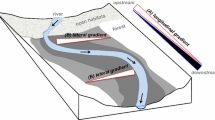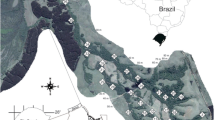Abstract
In most forested landscapes, the organization of plant communities across stream valleys is thought to be regulated by a complex set of interactions including flooding, landform properties, and vegetation. However, few studies have directly examined the relative influence of frequent and infrequent flooding, as well as landform properties, on riparian plant community organization in moderately or deeply entrenched stream valleys where the magnitude and extent of frequent flooding may be constrained by local stream valley characteristics. Our approach, which we applied in an old-growth northern hardwood watershed, integrated detailed plant community surveys with a GIS and watershed surface hydrology model that allowed us to model water surface elevation associated with different flood magnitudes and recurrence intervals for specific locations across the old-growth watershed. Our results show that irrespective of stream valley geomorphology, the ground-flora exhibits a high rate of species replacement across the stream valley at low elevations, which are the most susceptible to frequent and more extreme infrequent flooding. However, over 50 % of the major shifts in ground-flora community composition and almost all of the shifts in overstory composition occur beyond the direct influence of flooding, especially in the high-gradient moderately and deeply entrenched stream valleys. In these areas, landform boundaries and changes in the environmental properties associated with these boundaries appear to be the primary factors controlling changes in vegetation across the stream valley.






Similar content being viewed by others
References
Auble GT, Friedman JM, Scott JL (1994) Relating riparian vegetation to present and future streamflows. Ecological Applications 4:544–554
Baker ME, Barnes BV (1998) The landscape ecosystem diversity of river floodplains in Northwest Lower Michigan. Canadian Journal of Forest Research 28:1405–1418
Baker ME, Wiley MJ (2004) Characterization of woody species distribution in riparian forests of Lower Michigan, USA using map-based models. Wetlands 24:550–561
Bendix J (1999) Stream power influence on southern California riparian vegetation. Journal of Vegetation Science 10:243–252
Bendix J, Hupp CR (2000) Hydrological and geomorphical impacts on riparian plant communities. Hydrological Processes 14:2977–2990
Brinson MM, Verhoeven J (1999) Riparian forests. In: Hunter ML Jr (ed) Maintaining biodiversity in forest ecosystems. Cambridge University Press, Cambridge, pp 265–299
Brosofske KD, Chen J, Naiman RJ, Franklin JF (1997) Harvesting effects on microclimatic gradients from small streams to uplands in western Washington. Ecological Applications 7:1188–1200
Corenbilt D, Steiger J, Tabacchi E (2010) Biogeomorphologic succession dynamics in a Mediterranean river system. Ecography 33:1136–1148
Corenblit D, Steiger J, Grunell AM, Naiman RJ (2009) Plants intertwine fluvial landform dynamics with ecological succession and natural selection: a niche construction perspective for riparian systems. Global Ecology and Biogeography 18:507–520
Dick D, Gilliam F (2007) Spatial heterogeneity and dependence of soils and herbaceous plant communities in adjacent seasonal wetland and pasture site. Wetlands 27:951–963
Dorr JA, Eschman DF (1970) Geology of Michigan. University of Michigan Press, Ann Arbor
Dunne T, Leopold LB (1978) Water in environmental planning. W.H. Freeman Publishers, San Francisco
Ford TE, Naiman RJ (1989) Groundwater–surfacewater relationships in boreal forest watersheds: dissolved organic carbon and inorganic nutrient dynamics. Canadian Journal of Fisheries and Aquatic Sciences 46:41–49
Francis RA, Corenblit D, Edwards PJ (2009) Perspectives on biogeomorphology, ecosystem engineering and self-organisation in island-braided fluvial ecosystems. Aquatic Sciences 71:290–304
Franz EH, Bazzaz FA (1977) Simulation of vegetation response to modified hydrologic regimes: a probabilistic model based on niche differentiation in a floodplain forest. Ecology 58:176–183
Frelich LE, Lorimer CG (1991) Natural disturbance regimes in hemlock-hardwood forest of the upper Great Lakes region. Ecological Monographs 61:145–164
Goebel PC (2001) Hydrogeomorphic controls on riparian areas of the northern Lake States. PhD Dissertation, Michigan Technological University, Houghton, MI
Goebel PC, Palik BJ, Pregitzer KS (2003a) Plant diversity contributions of riparian areas in watersheds of the northern Lake States, USA. Ecological Applications 13:1595–1609
Goebel PC, Pregitzer KS, Palik BJ (2003b) Geomorphic influences on large wood dam loadings, particulate organic matter and dissolved organic matter in an old-growth northern hardwood watershed. Journal of Freshwater Ecology 18:479–490
Goebel PC, Pregitzer KS, Palik BJ (2006) Landscape hierarchies influence riparian ground-flora communities in Wisconsin, USA. Forest Ecology and Management 230:43–54
Gregory SV (1999) Riparian management in the 21st century. In: Kohm KA, Franklin JF, Thomas JW (eds) Creating a forestry for the 21st Century. Island Press, New York, pp 69–85
Gregory SV, Swanson FJ, McKee WA, Cummins KW (1991) An ecosystem perspective of riparian zones. BioScience 41:540–551
Gurnell AM, Petts GE, Hannah DM, Smith BPG, Edwards PJ, Kollmann J, Ward JV, Tockner K (2001) Riparian vegetation and island formation along the gravel-bed Fiume Talgliamento, Italy. Earth Surface Processes and Landforms 26:31–62
Gurnell AM, Tockner K, Petts GE, Edwards PJ (2005) Effects of deposited wood on biocomplexity of river corridors. Frontiers in Ecology and the Environment 3:377–382
Herman KD, Masters LA, Penskar MR, Reznicek AA, Wilhelm GS, Brodowicz WW (1996) Floristic quality assessment with wetland categories and computer application programs for the state of Michigan. US Fish and Wildlife Service, St. Petersburg
Hobbs ER (1986) Characterizing the boundary between California annual grassland and coastal sage scrub with differential profiles. Vegetatio 65:115–126
Holmes KL, Goebel PC, Hix DM, Dygert CE (2005) Ground-flora composition and structure of floodplain and upland landforms of an old-growth headwater forest in north-central Ohio. Journal of the Torrey Botanical Society 132:62–71
Holmes KL, Goebel PC, Morris AEL (2010) The distribution and characteristics of downed wood across headwater riparian ecotones: integrating the stream with the riparian area. Canadian Journal of Forest Research 40:1604–1614
Hough JL (1958) Geology of the Great Lakes. University of Illinois Press, Urbana
Howard AD, Fairbrisge RW, Quinn JH (1968) Terraces, fluvial introduction. In: Fairbridge R (ed) The encyclopedia of geomorphology. Reinhold Publishing, New York, pp 117–1123
Hupp CR (1983) Vegetation pattern on channel features in the Passage Creek Gorge, Virginia. Castanea 48:62–72
Hupp CR, Osterkamp WR (1985) Bottomland vegetation distribution along Passage Creek, Virginia, in relation to fluvial landform. Ecology 66:670–681
Hupp CR, Osterkamp WR (1996) Riparian vegetation and fluvial geomorphic processes. Geomorphology 14:277–295
Ilhardt BL, Verry ES, Palik BJ (2000) Defining riparian areas. In: Verry ES, Hornbeck JW, Dolloff CA (eds) Riparian management in forests of the continental Eastern United States. Lewis Publishers, New York, pp 23–42
Johnston CA, Pastor J, Pinay G (1992) Quantitative methods for studying landscape boundaries. In: Hansen AJ, di Castri F (eds) Landscape boundaries: consequences for biotic diversity and ecological flows. Springer, New York, pp 107–123
Kozlowski TT (1984) Responses of woody plants to flooding. In: Kozolowski TT (ed) Flooding and plant growth. Academic Press, San Diego, pp 129–163
Lorimer CG, Frelich LE (1984) A simulation of equilibrium diameter distributions of sugar maple (Acer saccharum). Bulletin of the Torrey Botanical Club 111:193–199
Ludwig JA, Cornelius JM (1987) Locating discontinuities along ecological gradients. Ecology 68:448–450
Lyon J, Sagers CL (1998) Structure of herbaceous plant assemblages in a forested riparian landscape. Plant Ecology 138:1–16
McCune B, Grace JB (2002) Analysis of ecological communities. MJM Software Design, Gleneden Beach
Morris AEL, Goebel PC, Palik BJ (2007) Geomorphic and riparian forest influences on characteristics of large wood and large wood jams in old-growth and second-growth forests in Northern Michigan, USA. Earth Surface Processes and Landforms 32:1131–1153
Mouw JEB, Stanford JA, Alaback PB (2009) Influences of flooding and hyporheic exchange on floodplain plant richness and productivity. River Research and Applications 25:929–945
Naiman RJ, Bilby RE, Bisson PA (2000) Riparian ecology and management in Pacific Coastal Rain Forest. BioScience 50:996–1011
Naiman RJ, Bechtold JS, Drake D, Latterell JJ, O’Keefe TC, Balian EA (2005) Origins, patterns, and importance of heterogeneity in riparian systems. In: Lovett GG, Jones CG, Turner MG, Weathers KC (eds) Ecosystem function in heterogeneous landscapes. Springer, New York, pp 279–309
Opperman JJ, Meleason M, Francis RA, Davies-Colley R (2008) “Livewood”: geomorphic and ecological functions of living trees in river channels. Bioscience 58:1069–1078
Osterkamp WR, Hupp CR (2010) Fluvial processes and vegetation—glimpses of the past, present, and perhaps the future. Geomorphology 116:274–285
Pabst RJ, Spies TA (1998) Distribution of herbs and shrubs in relation to landform and canopy cover in riparian forests of coastal Oregon. Canadian Journal of Botany 76:298–315
Palik BJ, Golladay SW, Goebel PC, Taylor BW (1998) Geomorphic variation in riparian tree mortality and stream coarse woody debris recruitment from record flooding in a coastal plain stream. Ecoscience 5:551–560
Pettit NE, Naiman RJ (2007) Fire in the riparian zone: characteristics and ecological consequences. Ecosystems 10:673–687
Pickett STA, White PS (eds) (1985) The ecology of natural disturbance and patch dynamics. Academic Press, Orlando
Reice SR (1994) Nonequilibrium determinants of biological community structure. American Scientist 82:424–435
Swanson FJ, Kratz TN, Caine N, Woodmansee RG (1988) Landform effects on ecosystem patterns and processes. BioScience 38:92–98
Swanson FJ, Johnson SA, Gregory SV, Acker SA (1998) Flood disturbance in a forested mountain landscape. BioScience 48:681–689
Verry ES (2000) Water flow in soils and streams: sustaining hydrologic function. In: Verry ES, Hornbeck JW, Dolloff CA (eds) Riparian management in forests of the continental Eastern United States. Lewis Publishers, New York, pp 99–124
Viereck LA, Dyrness CT, Foote MJ (1993) An overview of the vegetation and soils of the floodplain ecosystems of the Tanana River, Interior, Alaska. Canadian Journal of Forest Research 23:889–898
Voss EG (1972) Michigan flora. Part I. Gymnosperms and monocots. Cranbrook Institute of Science, Bloomfield Hills
Voss EG (1985) Michigan flora. Part II. Dicots (Saururaceae—Cornaceae). Cranbrook Institute of Science, Bloomfield Hills
Voss EG (1996) Michigan flora. Part III. Dicots (Pyrolaceae—Compositae). Cranbrook Institute of Science, Bloomfield Hills
Yarie J, Viereck L, Van Cleve K, Adams P (1998) Flooding and ecosystem dynamics along the Tanana River. BioScience 48:690–695
Acknowledgments
The USDA Forest Service, North Central Research Station, School of Forestry and Wood Products, Michigan Technological University, and Ohio Agricultural Research and Development Center at The Ohio State University provided support for this study. We thank Anita Risch, Anitra Bennett, and Michelle Jarvi for assistance with data collection. Additionally, we appreciate the support of Jiquan Chen, Peg Gale, Robert Naiman, and two anonymous referees who reviewed earlier versions of this manuscript.
Author information
Authors and Affiliations
Corresponding author
Electronic supplementary material
Below is the link to the electronic supplementary material.
ESM 1
(DOC 647 kb)
Rights and permissions
About this article
Cite this article
Goebel, P.C., Pregitzer, K.S. & Palik, B.J. Influence of Flooding and Landform Properties on Riparian Plant Communities in an Old-Growth Northern Hardwood Watershed. Wetlands 32, 679–691 (2012). https://doi.org/10.1007/s13157-012-0300-1
Received:
Accepted:
Published:
Issue Date:
DOI: https://doi.org/10.1007/s13157-012-0300-1




